The Worker Bee
The worker bee was not accustomed to serving, like her drone brother, as a cautionary tale. After all, she was thoroughly ensconced in a literary tradition that framed her as an exemplar of industry and virtue. In The Snail, the Tulip, and the Bee118, Pulter imagines a solitary bee independent of her hive starting her day in the garden as an “active Amazonian maid” and ending it with a futile and self-imposed trial that will precipitate her untimely death (7). In Pulter’s depiction, this bee offers a warning to those who would “struggle against their destiny” (38). Given the frequency of the garden setting in Pulter’s poems (see Whitney Sperrazza’s Curation, Pulter’s Garden), it is perhaps unsurprising that bug life features so prominently in her verse, including images of bees in To Aurora [3]34 and Why Must I Thus Be Forever Confined57; spiders in “The Snail, the Tulip, and the Bee” (Emblem 53), The Ugly Spider102, and The Toad and the Spider88; and ants in The Pismire35. In Emblem 53, Pulter engages with the apian tradition while also offering an inventive reconsideration of honeybee self-sacrifice.
The viewpoint of the beehive as a model for the ideal government of human societies is well established within the literary tradition. The image of the well governed and orderly hive is popularized in Book 4 of Virgil’s Georgics:
- Of all the Race of Animals, alone
- The Bees have common Cities of their own:
- And common Sons, beneath one Law they live,
- And with one common Stock their Traffick drive.
- …
- All is the States, the State provides from all.
- Mindful of coming Cold, they share the Pain
- And hoard, for Winter’s use, the summer’s gain.
Moses Rusden’s A Further Discovery of Bees (1679) offers a visual representation of the tradition that depicts the sovereign bee as king, or rex, with an established hierarchy of rank and duties descending from this leader:
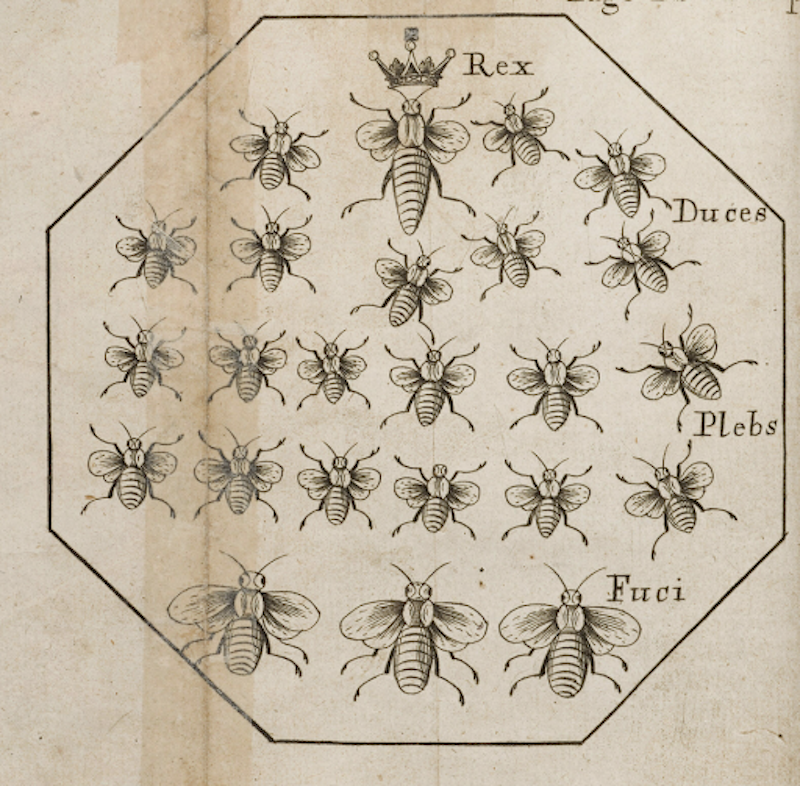
Moses Rusden, A Further Discovery of Bees (London, 1679), n.p. Credit: Wellcome Collection. Public Domain.
In early modern England, many writers and beekeepers sought to expand the understanding of apian virtue, holding up hive culture as exemplary in chastity, order, obedience, cleanliness, discernment, and self-sacrifice. Shakespeare’s Archbishop of Canterbury, in his effort to convince Henry V to wage battle in France while simultaneously directing English troops to defend against Scottish incursion, marshals the beehive as representative of human social structures:
- For so work the honey-bees,
- Creatures that by a rule in nature teach
- The act of order to a peopled kingdom.
- They have a king, and officers of sorts;
- Where some, like magistrates, correct at home,
- Others, like merchants, venture trade abroad
- Others, like soldiers, armed in their stings,
- Make boot upon the summer’s velvet buds,
- Which pillage they with merry march bring home
- To the tent-royal of their emperor;
- Who, busied in his majesty, surveys
- The singing masons building roofs of gold,
- The civil citizens kneading up the honey,
- The poor mechanic porters crowding in
- Their heavy burdens at his narrow gate,
- The sad-eyed justice, with his surly hum,
- Delivering o’er to executors pal
- The lazy yawning drone.
John Milton’s epic simile in Book 1 of Paradise Lost depicts Satan’s hoards of demons as a swarming hive in spring, ready for the great consult:
- As bees
- In spring time, when the Sun with Taurus rides,
- Pour forth thir populous youth about the Hive
- In clusters; they among fresh dews and flowers
- Flie to and fro, or on the smoothed Plank,
- The suburb of thir Straw-built Citadel,
- New rub’d with Baume, expatiate and confer
- Thir State affairs. So thick the aerie crowd
- Swarm’d and were strait’n’d.
John Levett’s The Ordering of Bees: or the True History of Managing Them (1634) depicts the common straw skep beehive. It is an upside down basket with an entrance placed on a stand to protect the hive from predators:
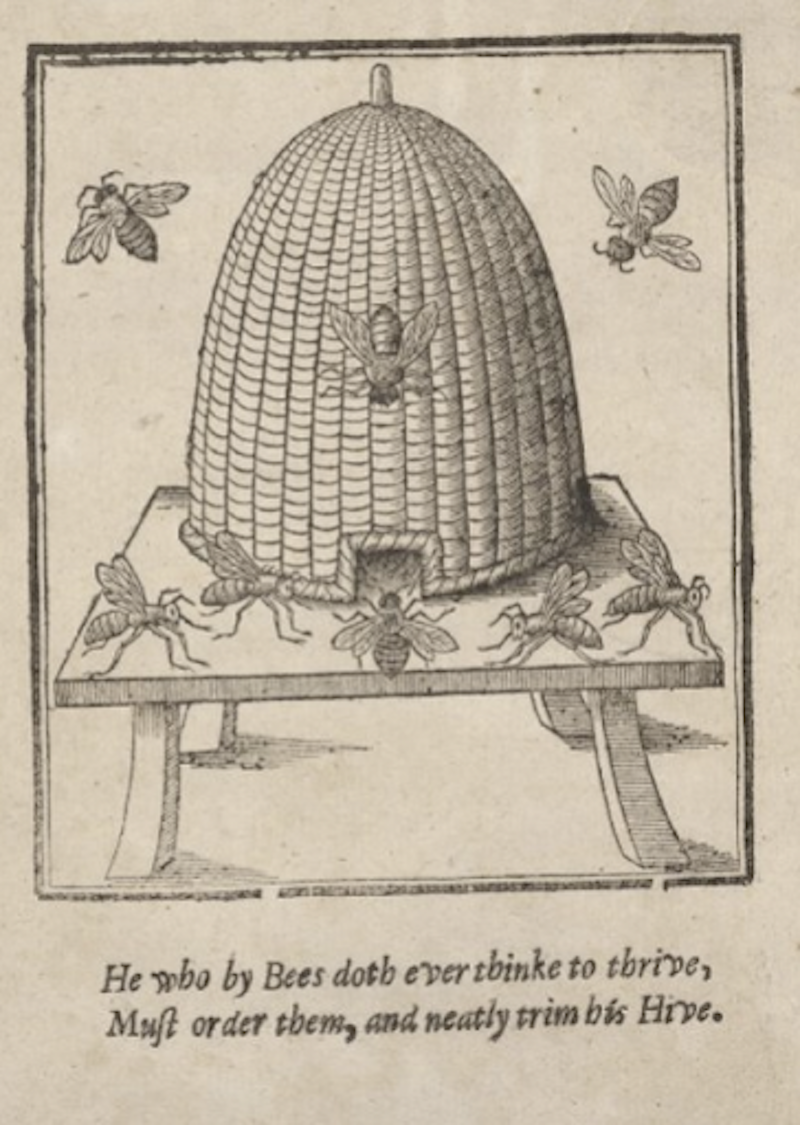
John Levett, The Ordering of Bees: or the True History of Managing Them (London, 1634), n.p. Credit: LUNA: Folger Digital Image Collection, Folger Shakespeare Library.
Whereas the classic tradition styled the sovereign bee as a king, the seventeenth century witnessed the growing consensus and eventual confirmation that she was a queen. In the preface to The Feminine Monarchie, Charles Butler indicates that he will translate all references of “Rex” in ancient texts to “Queene, sith the males heer beare no sway at al[l], this being an Amazonian or feminine kingdom” (Charles Butler, The Feminine Monarchie [Oxford, 1609], n.p., emphasis in original). Butler’s influential work is largely responsible for popularizing the understanding that queens and worker bees are female and drones male. Moreover, from 1669 to 1673, Jan Swammerdam confirmed these findings through microscopic examination. Pulter’s depiction of the worker bee as “the active Amazonian maid” thus demonstrates contemporary knowledge of bee sex and social structure (7).
Honeybee physiology offers only a glimpse into Pulter’s substantial engagement with natural history. As many scholars observe, Pulter’s verse demonstrates her understanding of alchemy, astronomy, and physics (see, for instance, Liza Blake, “Hester Pulter’s Particle Physics and the Poetics of Involution,” Journal for Early Modern Cultural Studies 20, no. 2 [Spring 2020]: 71-98. See also Nicole A. Jacobs, “Worker Bee Sacrifice,” in Bees in Early Modern Transatlantic Literature: Sovereign Colony [Routledge, New York, 2021], 131-58). Pulter’s emblems on animals, plants, and alchemical processes bridge the divide between scientific knowledge and literary representation, highlighting both the physical and symbolic importance of non-human life.
Francis Bacon’s Novum Organum (1620) frames scientific enterprise through insect and arachnid metaphors. In his representation, researchers may follow three potential symbolic pathways: the ant, the spider, or the bee. Bacon rejects the straightforward empiricism of those practitioners who act as collector ants or the dogmatism of those who emulate the crafty spider. To Bacon, the female worker bee offers a middle way to scientists who explore the raw material available and craft a well reasoned interpretive framework:
Those who have treated of the sciences have been either empirics or dogmatic. The former like ants only heap up and use their store, the latter like spiders spin out their own webs. The bee, a mean between both, extracts matter from the flowers of the garden and the field, but works and fashions it by its own efforts. The true labor of philosophy resembles hers, for it neither relies entirely or principally on the powers of the mind, not yet lays up in the memory the matter afforded by the experiments of natural history and mechanics in its raw state, but changes and works it in the understanding.
John Thorley’s Melisselogia: or the Female Monarchy (1744) includes a fold-out image depicting the author in his study transcribing observations about dead bees. His hives, visible through the adjacent window, are thriving as one colony swarms on the branch above the hive stand:
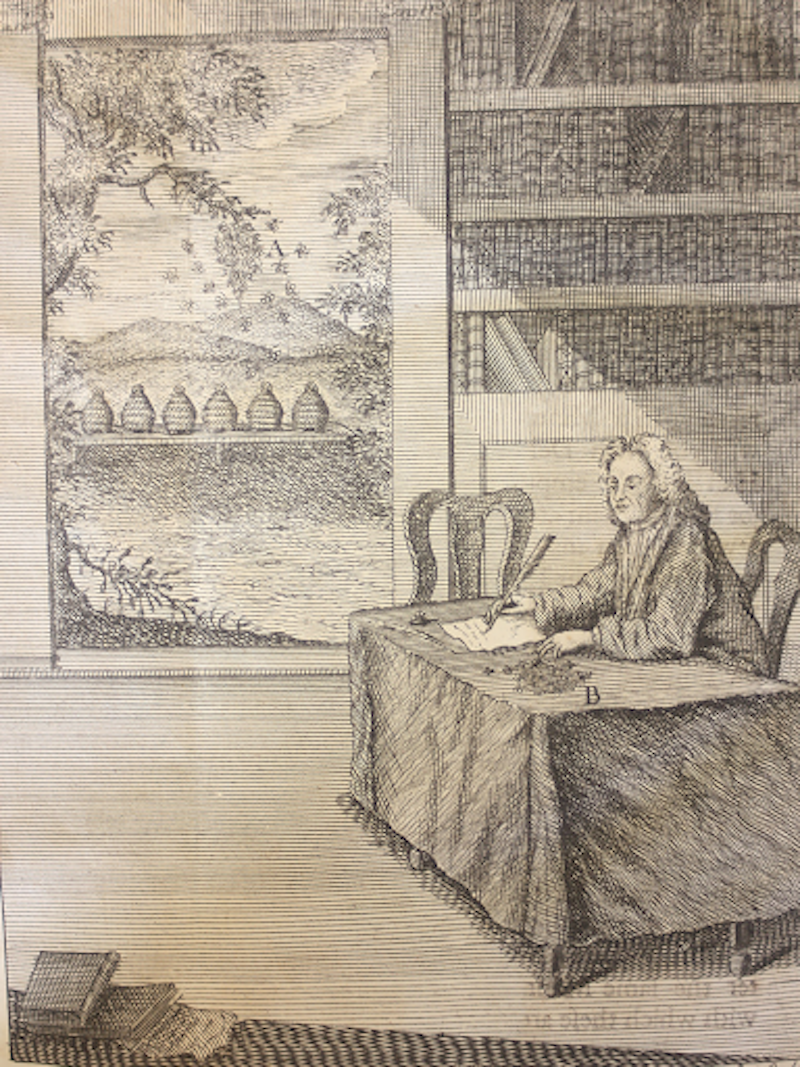
John Thorley, Melisselogia: or the Female Monarchy (London, 1744), n.p.
Charles Butler, importantly, frames bees’ self-sacrifice for the collective as noble and praiseworthy:
But the labour of the old ones is only in gathering, which they will never give over, while their wings can bear them & then when they cease to worke, they will cease also to eate: such enemies are they to idleness. And therefore generally they die in their delightful labour either in the field or coming home.
The notion that a bee, unlike a drone, would work itself to death is well established in the early modern period. However, Pulter’s depiction of this worker as “covetous” (22), a negative character trait, is decidedly less common. Andrew Marvel’s Upon Appleton House (c. 1651-3) also includes a bee that spends a night in a tulip. Karen Britland makes a case for the possibility that Pulter and Marvell were aware of one another’s work (Karen Britland, “Conspiring with ‘friends’: Hester Pulter’s Poetry and the Stanley Family at Cumberlow Green,” The Review of English Studies 69, no. 292 [2018]: 832-54). Unlike Pulter’s worker, however, Marvell’s bee is a soldier ordered to stand guard:
- But when the vigilant Patroul
- Of Stars walks round about the Pole,
- Their leaves, that to stalks are curl’d,
- Seem to their Staves the Ensigns furl’d.
- Then in some Flow’rs beloved hut
- Each Bee as Sentinel is shut;
- And sleeps so too: but, if once stir’d,
- She runs you through, nor asks the Word.
John Evelyn, John Thorley, and several other beekeepers of the seventeenth and eighteenth centuries address the knowledge and prevalence of women beekeepers. By the nineteenth century, there were some efforts to make beekeeping more accessible among genteel and aristocratic ladies, especially given the heavy labor required for using bee boxes instead of straw skeps. Whereas skeps required the beekeeper to kill the bees in order to harvest the honey and wax, the stacked box design allowed him or her to collect hive materials while preserving the bees. Samuel Bagster’s The Management of Bees with a Description of the “Ladies Safety Hive” (1834) introduces the innovative apiary designs of Madame Vicat, which allowed the keeper to lift more easily individual boxes that were lined up sequentially rather than stacked:
Mad[ame] Vicat, a native of Switzerland, has contributed very largely to the knowledge of the natural history of the bee, and having observed great inconvenience attending the use of boxes or hives, which are placed on one another, she contrived a hive formed of collateral boxes. … This hive is composed of its four [parallel] boxes, screwed fast together.
Samuel Bagster’s The Management of Bees with a Description of the “Ladies Safety Hive” (1834) includes this image of Madame Vicat’s novel box hive design. In modern beekeeping, top-bar hives replicate some of the accessibility of Vicat’s hive:
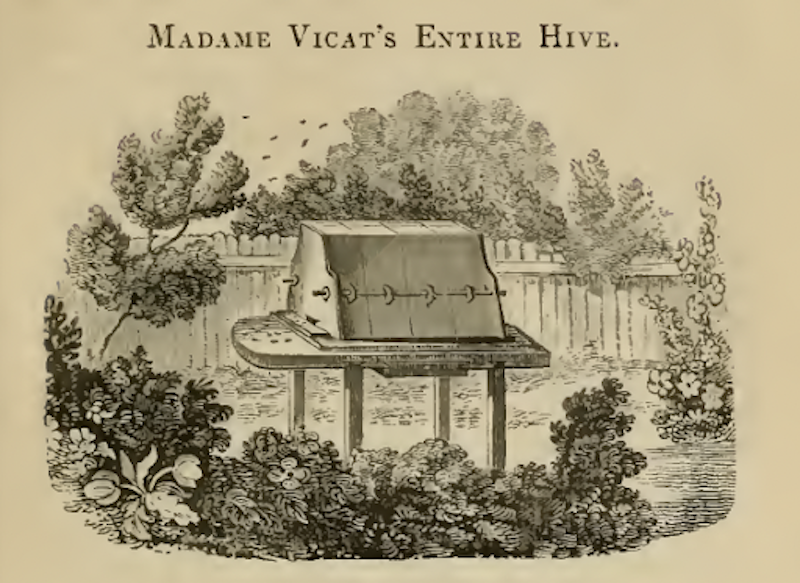
Samuel Bagster, The Management of Bees with a Description of the “Ladies Safety Hive” (London, 1834), p. 101: Internet Archive.
Rusden’s A Further Discovery of Bees depicts a hexagonal box design that would allow beekeepers to harvest honey and wax while preserving their hive. As with Sir Christopher Wren’s hive, which he designed in the 1650s as a fellow of All Souls College, Rusden’s hive includes a glass observation window (the crosshatched section on the top box):
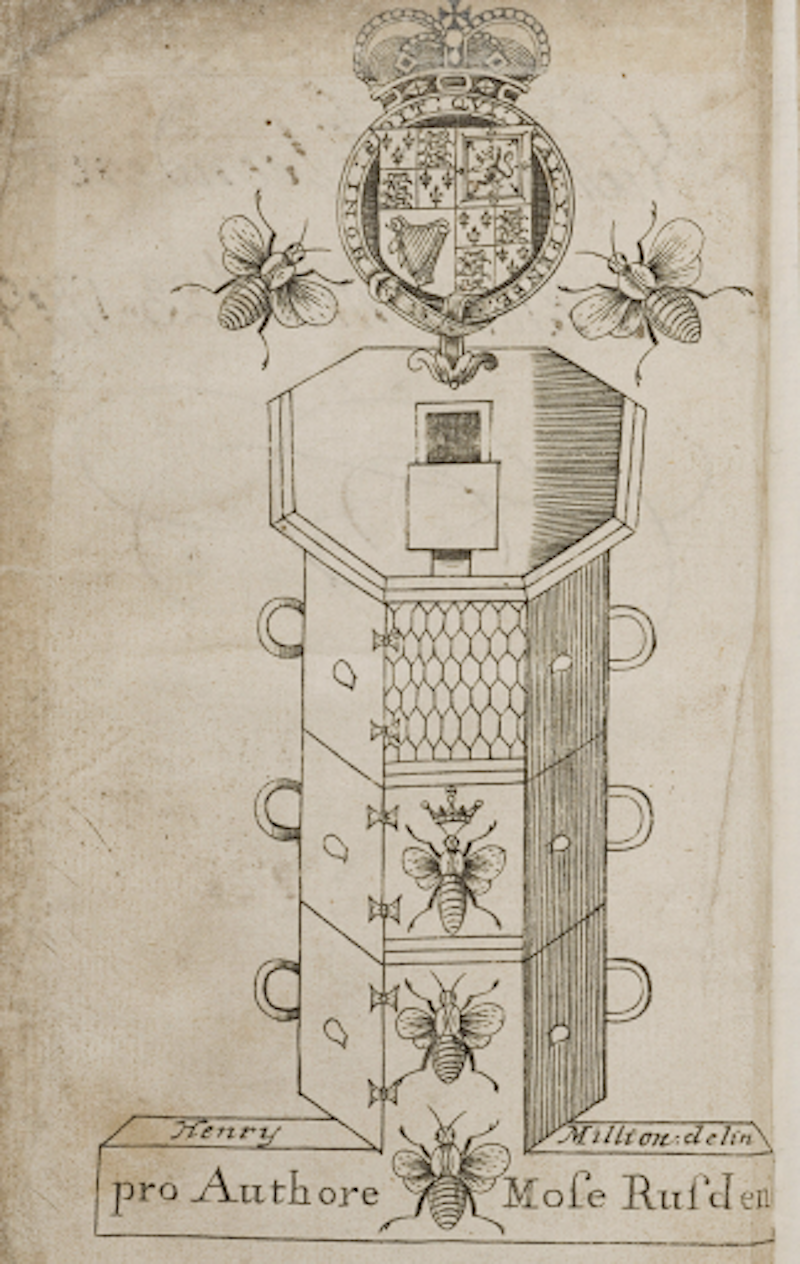
Moses Rusden, A Further Discovery of Bees (London, 1679), n.p. Credit: Wellcome Collection. Public Domain.
Further reading: Thomas Hill, A Profitable Instruction of the Perfect Ordering of Bees (1568), Edmund Southerne, A Treatise Concerning the Right Use and Ordering of Bees (1593), Samuel Purchas, A Theatre of Political Flying Insects (1657), and John Worlidge, Apiarium: or a Discourse of Bees (1676).